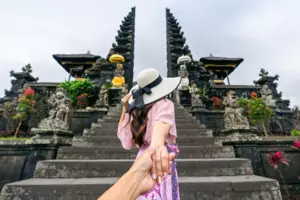
Bali Tourism Tax Explained + Best Historical Tourism Spots for Australian Travellers
If you’re planning a holiday to Bali from Australia, one important topic to understand is Bali tourism tax. Introduced to help fund cultural preservation and sustainable tourism, this levy is something you should pay attention to before you book your flight and accommodation. At the same time, Bali is rich in heritage and offers incredible experiences when exploring historical tourism in Bali. From ancient temples perched on the cliffs to rice terraces and royal palaces, the island’s past is visible everywhere and well worth the visit.
What You Need to Know About Bali Tourism Tax
The Bali tourism tax, often called the tourism levy, came into effect on 14 February 2024. Based on information from wonderplan.ai that describes Bali Tax, all international visitors to Bali must pay a one-time fee of IDR 150,000 (approximately USD $10 or AUD $15) regardless of how long you stay.
And also information based on bali.com, this means as an Australian traveller you should budget for this charge when flying to Bali. Payment can typically be made online in advance via the official portal or on arrival at arrival counters.
Why the Tourism Tax Matters for Australians
As an Australian, you will want to plan ahead. The Bali tourism tax is modest, but ignoring it could cause delays or complications when you land. While many travellers report that checks are still informal, enforcement is expected to tighten over time.
Understanding this tax also reflects responsible travel: you’re contributing to Bali’s cultural preservation and environmental initiatives. With many Australians visiting Bali each year, this tax helps support the local communities and heritage sites you’ll want to explore when engaging in historical tourism in Bali.
Top Historical Tourism in Bali: Must-See Sites
Bali is not only about beaches and wellness; it has a deep, layered history you’ll want to discover through historical tourism in Bali. Below are some of the best places where history lives vividly.
1. Besakih Temple
Often called the “Mother Temple” of Bali, Besakih is located on the slopes of Mount Agung and dates back to at least the 10th century. This grand complex allows you to explore numerous shrines and soak in dramatic views of volcanic slopes.
Visiting Besakih gives you insight into how Balinese Hinduism has been practiced over centuries and how local culture adapts to natural forces. It’s a hallmark for historical tourism in Bali which travellers seeking meaningful cultural exploration should not miss.
2. Goa Gajah (Elephant Cave)
Goa Gajah is an archaeological site believed to date from the 11th century, offering a fascinating glimpse of early Balinese spiritual life. The carved cave entrance and surrounding bathing pools make this site both photogenic and culturally significant.
For those interested in historical tourism in Bali, Goa Gajah provides a quieter alternative to the busier temple spots while still delivering powerful heritage and local context.
3. Tirta Empul Temple
Known for its holy spring water and purification ceremony, Tirta Empul dates back to 962 CE and remains deeply important in Balinese religious life. Visitors can observe or participate in cleansing rituals, adding to the immersive nature of historical tourism in Bali.
When you arrive, dress modestly, bring a sarong if required, and take time to understand the spiritual significance of the site.
4. Tanah Lot Temple
Perched on a rocky outcrop overlooking the ocean, Tanah Lot is one of Bali’s most iconic sea temples, built around the 16th century. Sunset visits here are popular with Australians and other travellers alike, combining scenic beauty and heritage in one.
For anyone engaged in historical tourism in Bali, Tanah Lot brings dramatic coastal views and a sense of timelessness.
5. Jatiluwih Rice Terraces & Subak System
Though more landscape than temple, the UNESCO-listed cultural landscape of Bali includes the rice terraces and their ancient irrigation system (subak), which dates back to the 9th century. This combination of agriculture, culture, and heritage offers a quieter but deeply historical experience than the more visited temples.
Visiting Jatiluwih and understanding the subak system connects you to Bali’s traditional ways and is a rewarding part of historical tourism in Bali.
How to Plan Your Visit to These Heritage Sites
To make the most of your experience with historical tourism in Bali, consider hiring a local guide who can explain the history and significance of each site. Many of these temples require modest dress and respectful behaviour. Arrive early to avoid crowds, especially at Besakih and Tanah Lot.
Since you will have paid the Bali tourism tax already, you’re set to enjoy these places with peace of mind knowing you’ve fulfilled the government requirement. Balancing your time between beach relaxation and cultural outings will provide a full sense of what Bali offers.
Ready to Stay and Explore?
If you’re looking for a comfortable and community-focused base while exploring Bali’s cultural heritage spots and satisfying your interest in historical tourism in Bali, consider staying at Alzeto Co Living.
This modern co-living space offers friendly guests, a relaxing atmosphere, and easy access to both cultural areas and natural beauty. Staying here means your Bali trip is not just about ticking boxes, it's about meaningful travel, connection, and comfort.
Published on 11 November 2025
